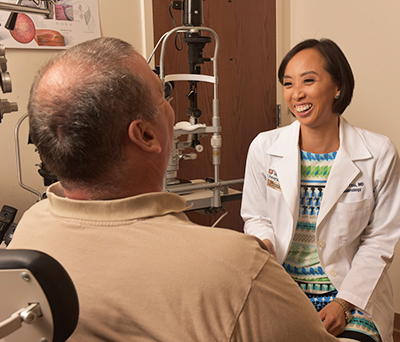
What if the world you could see was only as far as how many fingers were being held in front of your face? What if you couldn’t see any letters on the eye chart – at all? What if you could not recognize your wife? This describes, Michael Scatizzi, a 53-year-old man who recently came to see Linda Tsai, MD, Washington University ophthalmologist and specialist in cataract surgery.
Dr. Tsai explains, “A cataract is the clouding of the lens in the eye. As people age, the proteins in the natural lens may clump together, making the lens opaque. Most cataracts are related to aging. However, researchers suspect there are several causes of cataracts, including smoking, diabetes, trauma, medication-related and ultraviolet-sunlight related.
Most cataracts grow slowly, and occasionally the vision loss has actually occurred over a long time in one eye, but it is not noticed by the patient until the ‘good’ eye is covered accidently.”
Mr. Scatizzi was unable to drive, work in the yard or even watch television. He was legally blind. She describes his medical history, “Michael was a highly nearsighted individual who wore glasses since middle school. When he developed his acute vision decrease, he was initially diagnosed with a corneal degenerative disease, along with his cataract that affected his visual prognosis and surgical options.
By the time he came to see me, it was obvious that the cataracts were the significant cause of his decreased vision and I did not find any corneal abnormality on my exam. However, even then, I was hesitant to promise him a full visual recovery after cataract surgery. His vision was so significantly decreased that it was difficult to tell what his visual potential would be, even after a perfect cataract surgery.”
New treatment
Cataract surgery has been successfully performed with manual incisions for 40 years. The newest technology now uses femtosecond laser (the one used to make LASIK flaps) to create the incision, open the lens capsule, treat corneal astigmatism, and pre-soften the lens prior to the phacoemulsification.
It is more precise, is arguably safer, and decreases the amount of ultrasonic energy needed to remove the lens. Using less ultrasonic energy is less stressful for the rest of the eye, especially the cornea, and leads to a faster visual recovery.
With the femtosecond laser, real-time, 3D images of the eye are mapped and used to guide the laser treatment. The laser only needs to fire for less than a minute to complete all its functions.
Recovery
Cataract surgery has a very quick recovery time, which is often based on how healthy the cornea is and how much energy was needed to remove the cataract. Patients can often see very well the day after surgery, and it improves rapidly over the next week.
Dr. Tsai encourages patience, as the best-corrected vision can often take weeks to stabilize. “Michael’s vision was 20/25+ without correction the first day after surgery, which was life-changing for him. Although patients are always happy with increased vision and function after cataract surgery, in this particular case, it was quite emotional. He and his wife, Dawn, were also some of the most grateful individuals I have ever had the pleasure to work with.
I was so grateful to be the surgeon who could improve his quality of life.”
To make an appointment with Dr. Tsai, please call 314-362-3937 (EYES)
Washington University Eye Center
Center for Advanced Medicine
4921 Parkview Place, Suite 12C
St. Louis, MO 63110
Barnes-Jewish West County Hospital
Medical Building Two
10 Barnes West Drive, Suite 201
Creve Coeur, MO 63141